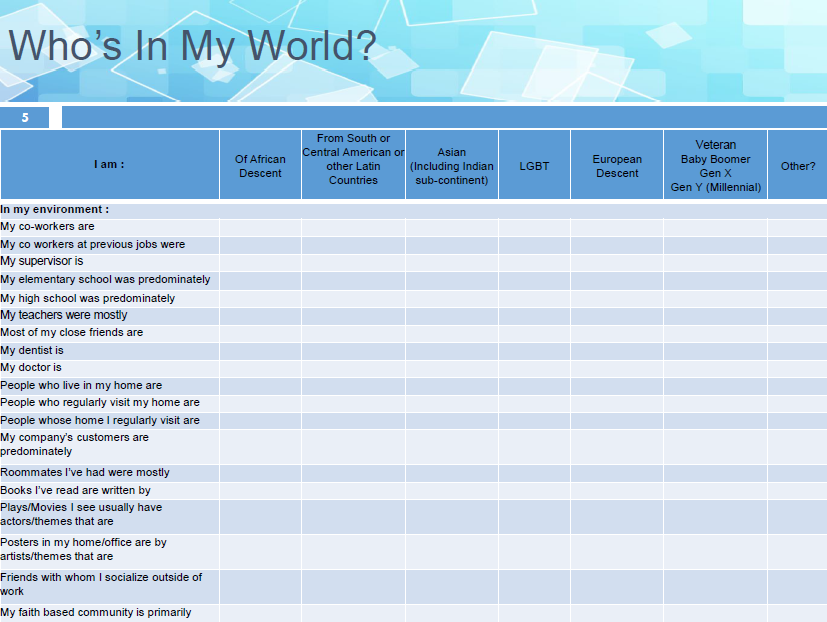
A few years ago, I wrote a blog post entitled “Free Innovation: Intercultural Competence Addresses Innovator Bias”. The theme of that post relied on numerous research, particularly the book, The Innovator’s DNA, by authors Jeff Dyer, Hal Gregersen, and Clayton Christensen, who made a simple, but powerful declaration that: “innovator’s go out of their way to meet people with different backgrounds and perspectives to extend their own knowledge.”
What I found most inspiring about the book was its encouragement for innovators to actively seek out cultural, ethnic, racial and gender diversity to foster new ideas.
To spur innovation, the authors encouraged “others to make a conscious effort to meet people with different education backgrounds; who hail from different countries, industries, and business functions; and who are of different ages, ethnic backgrounds,… socioeconomic groups, political groups, and religions, etc. … Diversity of networks breeds diversity of ideas.”
During The Winters Group Cross-Cultural Competence training, we make a similar recommendation by encouraging participants to complete the “Who’s In My World” exercise.

The exercise requires participants to reflect and record the diversity of their closest contacts, or “go to” people. We believe this exercise is a start at knowing more about themselves and others. We also believe that intercultural competence is the vital link that allows an individual to transform a diversity of people into a collection of appreciated values, experiences, and ideas that make innovation possible, that make one’s life richer.
Thus, during my sessions, I define intercultural competence as the mindset, knowledge set and skill set to work effectively across different cultures.
The mindset is being open minded, flexible and adaptable. During The Winters Group Cross-Cultural Competence training, we assess and foster this mindset through the use of the Intercultural Development Inventory (IDI). I have completed and administered IDI assessments and utilized Business Resource Groups (BRGs) such as the McDonald Investments National Association of Security Professionals (McD NASP); BP Hispanic Network; Campbell Soup Asian Network; Ahold Women Adding Value and ALANA to help myself and others move along the Intercultural Development Continuum (IDC™).
The knowledge set is knowledge of oneself and others. We utilize many tools to expand one’s self-knowledge such as Emotional Intelligence (EQ) assessments, Life Orientation (LIFO) assessments, My Cultural Identity exercise, and Who’s In My World exercise. As with the IDI, I have both completed and administered many LIFO assessments to help myself and others learn their strengths and understand the harmful impact of their strengths overused.
The skill set is effective listening, observing and communicating. The Winters Group’s DNA Model™ (Describe, Navigate, and Adapt) provides a method to funnel intercultural competence learning into a practical tool that accelerates individual and team effectiveness, efficiency and innovation.
Thus, the role of intercultural competence for innovation is to help individuals have the mindset, knowledge set and skill set to appreciate, foster and utilize their “Idea (My World) Network” effectively. As numerous research details, it is not enough that we surround ourselves with a diversity of people, if we hope to foster innovation, or creativity.
Without the existence of intercultural competence, a diversity of people can simply lead to assimilation, minimization and conflict. Intercultural competence generates the necessary inclusion, the essential personal adaptation, so that others feel respected and appreciated for their uniqueness. Many of us have probably experienced being among a diverse group of people but having one individual’s (maybe the group leader’s) style or the organization’s existing culture maintain the status-quo.
The role of intercultural competence is to help individuals accept and then adapt their mindset, knowledge set and skill set to leverage the unique experiences, ideas and perspectives that is essential for innovation.



















how do we assess intercultural competence?
We use the Intercultural Development Inventory (IDI) to assess intercultural competence at both the group (organizational) and individual level.